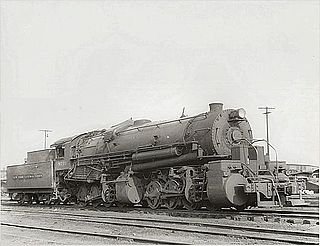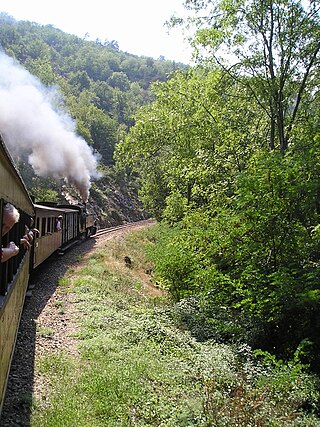
A Mallet locomotive is a type of compound articulated steam locomotive, invented by the Swiss engineer Anatole Mallet (1837–1919).
The UIC classification of locomotive axle arrangements, sometimes known as the German classification or German system, describes the wheel arrangement of locomotives, multiple units and trams. It is used in much of the world, notable exceptions being the United Kingdom and North America.
Under the Whyte notation for the classification of steam locomotive wheel arrangements, a 2-10-10-2 is a locomotive with two leading wheels, two sets of ten driving wheels, and a pair of trailing wheels.

In the Whyte notation for classifying the wheel arrangement of steam locomotives, an 0-8-8-0 is a locomotive with two sets of eight driving wheels and neither leading wheels nor trailing wheels. Two sets of driving wheels would give far too long a wheelbase to be mounted in a fixed locomotive frame, so all 0-8-8-0s have been articulated locomotives of the Mallet type, whether simple or compound. In the UIC classification, this arrangement would be, refined to Mallet locomotives, (D)D. The type was sometimes called Angus in North America.
A 2-8-8-2, in the Whyte notation for describing steam locomotive wheel arrangements, is an articulated locomotive with a two-wheel leading truck, two sets of eight driving wheels, and a two-wheel trailing truck. The equivalent UIC classification is, refined to Mallet locomotives, (1'D)D1'. These locomotives usually employ the Mallet principles of articulation—with the rear engine rigidly attached to the boiler and the front engine free to rotate—and compounding. The 2-8-8-2 was a design largely limited to American locomotive builders. The last 2-8-8-2 was retired in 1962 from the N&W's roster, two years past the ending of steam though steam was still used on steel mill lines and other railroads until 1983.

In the Whyte notation for the classification of steam locomotive wheel arrangement, an 0-4-4-0 is a locomotive with no leading wheels, two sets of four driving wheels, and no trailing wheels. The arrangement is chosen to give the articulation of a locomotive with only the short rigid wheelbase of an 0-4-0, but with its weight spread across eight wheels, and with all the weight carried on the driving wheels; effectively a flexible 0-8-0. Articulated examples were constructed as Mallet, Meyer, BMAG and Double Fairlie locomotives and also as geared locomotives such as Shay, Heisler, and Climax types. A similar configuration was used on some Garratt locomotives, but it is referred to as 0-4-0+0-4-0. In the electric and diesel eras, the Bo-Bo is comparable and closest to the Meyer arrangement of two swivelling bogies.

Under the Whyte notation for the classification of steam locomotives, a 4-8-8-2 is a locomotive with four leading wheels, two sets of eight driving wheels, and a two-wheel trailing truck.
In Whyte notation, 2-4-4-2 refers to a railroad steam locomotive that has two leading wheels followed by two sets of four coupled driving wheels and two trailing wheels.
Under the Whyte notation for the classification of steam locomotives, a 2-8-8-8-4 has two leading wheels, three sets of eight driving wheels, and four trailing wheels.

A 2-6-8-0 steam locomotive, in the Whyte notation for describing locomotive wheel arrangements, has two leading wheels, a set of six driving wheels, a set of eight driving wheels, and no trailing wheels. These locomotives usually employ the Mallet principle of articulation, with a swinging front engine and a rigidly attached rear engine.

Établissements Billard was a French railway rolling stock construction company founded in 1920 and based in Tours. It specialised in light railbuses and metre gauge and narrow gauge rolling stock. The business ceased trading in 1956 and later became Socofer.

The du Bousquet locomotive was an unusual design of articulated steam locomotive invented by French locomotive designer Gaston du Bousquet. The design was a tank locomotive, carrying all its fuel and water on board the locomotive proper, and a compound locomotive. The boiler and superstructure were supported upon two swivelling trucks, in a manner similar to a Meyer locomotive.

For more than a century, the Swiss locomotive, multiple unit, motor coach and railcar classification system, in either its original or updated forms, has been used to name and classify the rolling stock operated on the railways of Switzerland. It started out as a uniform system for the classification and naming of all rolling stock, powered and unpowered, but had been replaced and amended by the UIC classification of goods wagons.

The Bavarian Class Gts 2x3/3 was a former narrow gauge, German Army, military railway, steam locomotive that was in service on the narrow gauge line from Eichstätt to Kinding.

The steam locomotives of the Württemberg Class C were built for the Royal Württemberg State Railways in the early 20th century and were Pacifics designed for hauling express trains. They were the smallest state railway Länderbahn locomotives with a 4-6-2 wheel arrangement.

The Chemin de fer du Vivarais (CFV) - often called Le Mastrou or Train de l'Ardèche - is a tourist railway in the Ardèche region of the South of France. The metre gauge line is 33 kilometres (21 mi) long. The railway is renowned for its historical steam locomotives in Mallet articulated locomotive style, as well as a collection of historic rolling stock and diesel railcars.

The Réseau Breton 4-6-0 tank locomotives were a class of metre gauge locomotives. The twelve class members were built in two batches by Franco-Belge and Fives-Lille for the Réseau Breton (RB) in France. Introduced in 1904, they were to be found all over the Réseau Breton system, lasting in traffic until the closure of the metre gauge lines in 1967.
A 0-6-2+2-6-0, in the Whyte notation for the classification of steam locomotives by wheel arrangement, is an articulated locomotive with two separate engine units with no leading wheels, six powered and coupled driving wheels on three axles, and two trailing wheels. The only examples were forms of the Meyer articulated locomotive.
Under the Whyte notation for the classification of steam locomotive wheel arrangements, a 4-4-6-2 is a locomotive with two pairs of leading wheels, one set of four driving wheels, a second set of six driving wheels, and a pair of trailing wheels.












